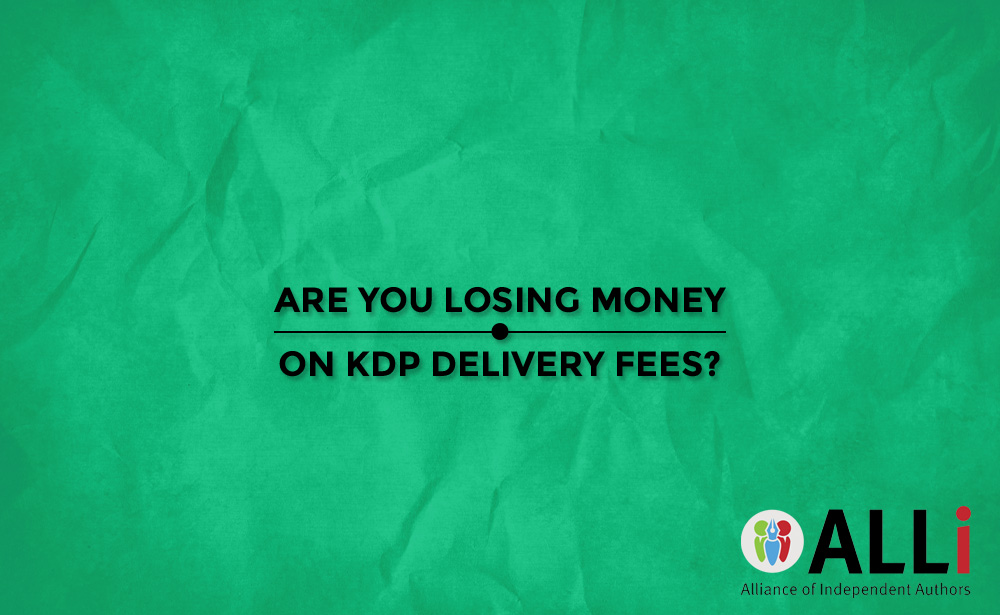Amazon is unique among ebook sellers in that they charge the publisher a fee to deliver each ebook (deducted from the royalties on the book). In most cases, this is a trivial fee that amounts to a few pennies… but those pennies can add up, and an incorrectly formatted ebook can cost you in the long run.
We'll examine several ways you can minimize this fee without compromising on content. We'll also debunk some of the myths and misunderstandings around delivery fees so you'll know what to watch out for, and what you can safely ignore.
The delivery fees
First, be aware that delivery fees are only assessed when the author is signed up for KDP's 70% royalty rate. The 35% rate is exempt from delivery charges.
Those in the 70% program will pay $0.15 USD per megabyte in the US, £0.10 per Mb in the UK, and similar fees for each of Amazon's regional stores. The minimum cost for any ebook is $0.01 USD.
But what is that fee based on? A Word document, an EPUB file, and a MOBI file for the same book will weigh in at substantially different file sizes. Should you upload the smallest file type available to you?
What you put in isn't what you get out
Delivery fees are based on the size of the file sent to the customer, not the size of the manuscript you upload to KDP. Amazon will compress and optimize your interior file in a number of ways that reduce the size of the final deliverable. The initial file size of your manuscript isn't a reliable indicator of what you'll pay in delivery fees.
Once you upload your interior file, the next page of KDP's dashboard will let you know what the delivery fee will be. The format you upload has little impact on the final size, because KDP's conversion process eliminates many of the differences between formats.
In particular, you should be aware that MOBI files will appear to be three to four times larger than the final deliverable. This is because the MOBI format encapsulates multiple versions of the ebook, only one of which is actually delivered to the Kindle reader.
Use whichever format gives you the best balance of quality and ease; it will have little to no impact on your delivery fees.
Fine-tune your images
Image compression technique is a topic that's a bit too technical for the scope of this article, but know that it's often possible to reduce the file size of an image without compromising on quality. When done properly, the compression should be unnoticeable. Too much compression, and your images can degrade into a blocky, Minecraft-esque clutter of pixels. The challenge here is finding the proper balance between file size and image quality.
Images are by far the largest source of delivery fee bloat. If your ebook contains graphic chapter headings, fleurons or dividers, a graphic title page or half-title, or illustrations, these should all be scrutinized carefully. If you use multiple copies of the same image, as with chapter headings or dividers, it may be possible to configure your ebook output to reference all of those images with a single copy. Proper compression and eliminating duplicates can have a big impact on your file size. (Jutoh—my preferred ebook editor—handles this quite nicely.)
You may notice that I left out one important image from the list above: your cover. As the largest image in your ebook, this one deserves its own section.
Usually, cover size doesn't affect your delivery costs
Last night, I had an interesting discussion with an author who had been told that an ebook cover affects the size of the file. This is contrary to what I was told by Amazon, so I was surprised to hear that an Amazon support rep had confirmed it.
Then I thought back on all the misinformation I've been given by Amazon support reps over the years, and decided to get to the bottom of it myself.
Remember that there are potentially two places for your cover: the KDP field that asks you to upload a separate image; and you can embed a cover image within the ebook.
I uploaded two short ebooks to KDP. Both were identical except for the cover, which was embedded in the EPUB itself as an image and also uploaded separately through KDP's cover uploader. The results:
Book 1
Cover: 1800 x 2700 with 50% compression, approx. 994k.
EPUB size: 998k.
Final deliverable size: 0.16 Mb.
Book 2
Cover: 3600 x 5400 with no compression, approx. 13 Mb.
EPUB size: 13.1 Mb.
Final deliverable size: 0.16 Mb.
In both cases, KDP took the uploaded cover, resized and optimized it, and replaced the interior cover with the optimized image. (I confirmed this with a second round of tests in which I altered the uploaded cover slightly.)
This means that the size of your cover image won't affect the size of the delivered ebook…usually.
In some cases (usually due to an incorrectly formatted interior file), KDP will fail to correctly identify the cover, and will instead add a duplicate cover image. This is costly, as you're padding the ebook with an unnecessary and unoptimized copy of your cover.
To avoid this, Amazon recommends that you do not include a cover in your ebook interior file.
However, in the majority of cases KDP will thoughtfully pluck out any cover embedded in the ebook and replace it with the optimized version, saving you unnecessary expense.
To sum up: Don't include your cover inside your ebook on KDP, and upload a high-resolution, uncompressed image separately.
Is it worth the time to audit your ebooks for size?
1 Mb is a typical file size for a 300-page book with small graphics. If you're paying for more than that, consider auditing your books. You may be short-changing yourself on royalties.
Shaving a few pennies off your delivery fees may not seem like much, but over your complete list of titles, over time, over tens of thousands of sales, that's an appreciable amount. Amazon doesn't need that money; wouldn't you rather have it?
Over to you
Do you optimize your ebooks for size? Let us know in the comments below!
#IndieAuthors, are you wasting money on ebook delivery fees? - by @johndoppler Click To Tweet




I’m wondering if anyone has noticed KDP’s higher cost for shipping author copies? For 25 books, used to be (early to mid 2020) 40-50 cents per book, now 72 cents for US domestic shipping bottom rate! They have us by the short-hairs–but is there anything we can do about it?
Really helpful article John. I write niche nonfiction which is quite technical and involves practical ‘how to’ guidance. I’ve had nightmares with tables when trying to create mobi and ePub files from Scrivener, so had to resort to images. For my next book I’m producing a pdf for download and giving a link in the book – and trying to make sure it’s far enough in not to be visible in the ‘Look Inside’ feature!
I do have a small image to signal each activity, which needs to be in there – is that likely to affect the download fee, and how do you compress the image and know what balance to go for, please?
I don’t agree with the cover advice of not including the cover image.
If you sell your MOBI files independently via eCommerce or distribute free copies via BookFunnel, etc., then you would be providing a MOBI file with no cover image, which is a bad thing.
Trad publishers don’t quite know what they’re doing, either. That’s why so many of them have a sort of place-holder cover inside their ebooks, (Generic single color, text only). When you receive their ebooks via 3rd parties such as eCommerce or into library applications like Calibre, their attractive covers (part of why you may have bought them) are not part of what you get. This is so common a fault that Calibre even has a feature to skim the retailer covers at the common retailer sites so that you can pick the right cover and have them stuff it into the ebook file, just to make up for the publisher’s inadequacies.
It’s better to learn how to properly define the cover image within an ebook file, or make sure your ebook formatter does it for you correctly. (It’s not hard…) Esp. since Amazon removes any penalty for so doing.
Hi Karen,
That advice was specifically for KDP only, and follows Amazon’s recommendations. For all other distributors, it makes perfect sense to include a cover image. Sorry if I was unclear!